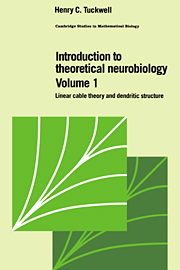Book contents
- Frontmatter
- Contents
- Preface
- 1 Introductory neuroanatomy and neurophysiology: the properties of motoneurons
- 2 The classical theory of membrane potentials
- 3 The Lapicque model of the nerve cell
- 4 Linear cable theory for nerve cylinders and dendritic trees: steady-state solutions
- 5 Time-dependent cable theory for nerve cylinders and dendritic trees
- 6 Rail's model neuron
- References
- Index
1 - Introductory neuroanatomy and neurophysiology: the properties of motoneurons
Published online by Cambridge University Press: 29 December 2009
- Frontmatter
- Contents
- Preface
- 1 Introductory neuroanatomy and neurophysiology: the properties of motoneurons
- 2 The classical theory of membrane potentials
- 3 The Lapicque model of the nerve cell
- 4 Linear cable theory for nerve cylinders and dendritic trees: steady-state solutions
- 5 Time-dependent cable theory for nerve cylinders and dendritic trees
- 6 Rail's model neuron
- References
- Index
Summary
The central nervous system
Our brains and spinal cords contain specialized cells called nerve cells or neurons, which are collectively referred to as the central nervous system (CNS). At one time it was thought that the nervous system was continuous, but it is now firmly established that the neuron is the fundamental discrete unit of the CNS. The nervous system is extremely complex and estimates of the number of nerve cells in the human brain are on the order of 10 billion (i.e., 1010). In addition, there are closely associated cells, as numerous or more so, called glial cells or glia, that seem to play an important regulatory role. They have several properties in common with neurons but are nevertheless quite distinguishable from them.
From location to location in the CNS, nerve cells differ in their properties and functions. It is convenient, however, to envisage a paradigm, or typical nerve cell, with four basic components (see Figure 1.1). The components and their usual roles are as follows.
Cell body or soma
This is the focal part from which branching structures emanate. It roughly delineates the input or information-gathering parts of the cell from the output or information-transmitting parts.
Dendrites
There are usually several dendrites that may branch several times to form treelike structures–the dendritic trees. Over the dendrites occur many contacts from other cells at specialized sites called synapses, though these are also often found on the cell body.
- Type
- Chapter
- Information
- Introduction to Theoretical Neurobiology , pp. 1 - 32Publisher: Cambridge University PressPrint publication year: 1988



